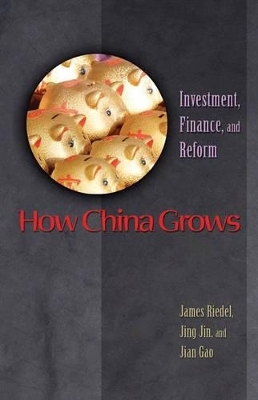
How China Grows
Princeton University Press (Verlag)
978-0-691-12562-6 (ISBN)
Although China's economy has grown spectacularly over the last twenty-five years, economists disagree about how the Chinese economy is likely to fare in the short- and long-term future. Is China's growth sustainable, or has China relied too much on investment, which is subject to diminishing returns, and not enough on technological change? The first book on the relation between investment, finance, and growth in China, How China Grows dismisses this concern. James Riedel, Jing Jin, and Jian Gao argue that investment has not only been the engine of growth, but also the main source of technological progress and structural change in China. What threatens future growth instead, the authors argue, are the weaknesses of China's financial system that undermine efficiency in investment allocation. Financial-sector reform and development are necessary, not only for sustaining long-term growth, but also for maintaining macroeconomic stability.
Although it includes some technical economic analysis, How China Grows is accessible to noneconomists and will benefit anyone who is interested in development finance in general and in China's economic growth in particular--whether economists, political scientists, bankers, or business people
James Riedel is Professor of International Economics at Johns Hopkins University's School of Advanced International Studies. Jing Jin is Director of China Strategy for UBS AG Hong Kong, and a professor at Beijing's Central University of Finance and Economics. Jian Gao is Vice-Governor of the China Development Bank in Beijing.
Preface ix Acknowledgments xi Chapter 1: Overview of Economic Reforms and Outcomes 1 1.1 Agricultural Reform: 1979-85 4 1.2 Industrial Reform: 1978-93 6 1.3 Transition to a Market Economy: 1994-2003 11 1.4 Foreign Trade and Investment 13 1.5 Financial Sector 16 Chapter 2: The Source of Growth and the Role of Investment 18 2.1 Methodology of Growth Accounting 18 2.2 Measurement of TFPG in China 20 2.3 Production Function Estimates of TFPG in China 23 2.4 Explaining TFPG in China 25 2.5 The Contribution of Investment Reconsidered 28 2.6 Technological Change Reconsidered 32 2.7 Postscript: Investment versus Domestic Demand as a Source of Growth 35 Chapter 3: Saving and the Financing of Investment in China 36 3.1 Investment 38 3.2 Financing Investment 42 3.3 Financial Flows between Sectors 45 3.4 Household Saving 47 3.5 Government Saving and Investment 54 3.6 Foreign Saving 60 3.7 Summary and Conclusions 65 Chapter 4: Financial Sector Repression 70 4.1 Why Repress the Financial System? 71 4.2 How Repressed Is China's Financial System? 74 4.3 Finance and Growth in China 84 4.4 Strategy of Financial Development 90 Chapter 5: Banking Sector Reform 93 5.1 Key Features of the Banking Sector 93 5.2 Problems of the Banking Sector 95 5.3 Measures Taken to Strengthen the Banking Sector 101 Chapter 6: Developments in the Bond Market 115 6.1 The Role of a Bond Market 115 6.2 The Bond Market in China 116 6.3 Government Bonds 118 6.4 Corporate Bond Market 131 6.5 Conclusion 132 Chapter 7: The Rise and Fall of the Stock Market 134 7.1 The Rise 135 7.2 The Fall 140 7.3 Conclusion 148 Chapter 8: Macroeconomic Policy and Performance 150 8.1 Ups and Downs in the Macro Economy 151 8.2 Investment Spending as the Proximate Cause of Macroeconomic Cycles 152 8.3 Anatomy of Macro Cycles in China 155 8.4 Monetary Policy 165 8.5 Capital Flows and Exchange Rate Policy 171 8.6 Fiscal Policy 179 8.7 Conclusion 186 References 189 Index 199
| Erscheint lt. Verlag | 8.4.2007 |
|---|---|
| Zusatzinfo | 72 b/w illus. 18 tables. |
| Verlagsort | New Jersey |
| Sprache | englisch |
| Maße | 140 x 216 mm |
| Gewicht | 369 g |
| Themenwelt | Wirtschaft ► Betriebswirtschaft / Management ► Finanzierung |
| Wirtschaft ► Volkswirtschaftslehre | |
| ISBN-10 | 0-691-12562-7 / 0691125627 |
| ISBN-13 | 978-0-691-12562-6 / 9780691125626 |
| Zustand | Neuware |
| Informationen gemäß Produktsicherheitsverordnung (GPSR) | |
| Haben Sie eine Frage zum Produkt? |
aus dem Bereich


